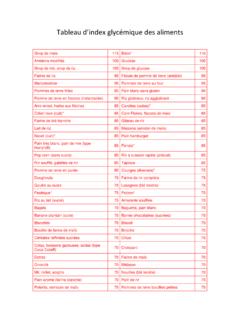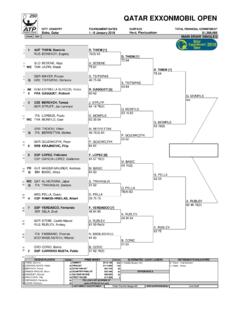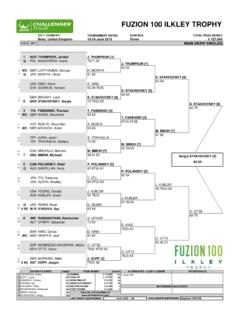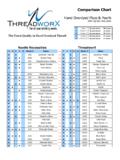Transcription of Simple Techniques for Making Every Data …
1 Visual Analysis Best PracticesSimple Techniques for Making Every Data Visualization Useful and Beautiful2 Table of ContentsStart with Questions ..5 Choose the Right Chart Type ..7 Trends over Time ..7 Comparison and Ranking ..9 Correlation ..10 Distribution ..11 Part to Data ..14 Create Effective the most important data ..16 Orient your views for your views ..18 Avoid overloading your views ..20 Limit the number of colors and shapes in a single view ..21 Design Holistic Dashboards ..22 General guidelines ..23 Give the wheel to your users with interactivity ..24 Highlighting ..25 Filters ..26 Hyperlinking and using the power of the web ..30 Sizing: Making sure your visualization is visible ..31 Scrollbars.
2 31 Scrunched views ..32 Fitting ..32 Perfecting Your Work ..33 Color TV looks better than black and white: Use color visualizations ..34 Fonts: Can you read this? (Can you read this?) ..35 Tooltips tell the story ..36 Make intelligent axes or you ll just have pretty rectangles ..37 Labeling your visualization in all the right places ..38 Evaluating Your Masterpiece ..393 About this paper You made a visualization! Congratulations: you are part of a small but growing group that s taking advantage of the power of visualization. However, bringing your visualizations from good to great takes time, patience and attention to detail. Luckily, we have compiled a short but important list of Techniques to get you started.
3 Happy visualizing! Note: This document does not provide basic instructions for building visualizations; we assume you know how to do that. The purpose of this document is to provide tips for Making your visualizations more effective. Below are examples of two visualizations: one that s good and another that s great. Why is one good and one great? Simply because the latter visualization helps you understand more about the data and more quickly. There are many ways to do this. We ll touch on the different Techniques throughout this Your VizGood vi sualiza tio nGrea t vi sualiza tio n0K1K2K3K4K5 KHome (sq ft)$0K$1,000K$2,000K$3,000K$4,000 KPriceHome Pr ices0K2K4K6 KHome (sq ft)$0M$1M$2M$3M$4 MPrice$ $ me Pri cesSelect Ty pe :SingleDuplexTr iplexMiscImproving Your VizGood vi sualiza tio nGrea t vi sualiza tio n0K1K2K3K4K5 KHome (sq ft)$0K$1,000K$2,000K$3,000K$4,000 KPriceHome Pr ices0K2K4K6 KHome (sq ft)$0M$1M$2M$3M$4 MPrice$ $ me Pri cesSelect Ty pe :SingleDuplexTr iplexMisc4 Start with Questions What are you trying to say?
4 The single most important step you can take to make a great visualization is to know what you re trying to say. With the amount of data available today, anyone can get lost in a world of scatter plots and geocoding. It is vital that your visualization has a purpose and you are selective about what you include in your visualization to fulfill that do you know if your visualization has a purpose? Well, ask some questions to find out. Who is your audience? What questions do they have? What answers do you find for them? What other questions does it inspire? What conversations will result? The point is that your viewers should take something away from the time they spend with your s say you work for a stock broker who focuses on IPO investments, and you want to make a visualization to help him decide where to invest.
5 You might ask a question like Does profitability at IPO affect stock performance? That might lead you to produce this view:From this view, you would discover that profitability at IPO has a huge effect on its later performance. However, this dataset contains information on all software company IPOs over the past three decades. You might wonder if the trend you ve discovered holds true throughout all periods. A second view could help you answer that question:You can see from this view that the trend only applies to the 1990s. Furthermore, you can now make two more discoveries: 1) All companies were profitable at IPO in the 1980s, and 2) Profitability at IPO didn t have a huge impact on stock performance in the 2000s.
6 Does this mean that modern investors are more risk-prone than their predecessors? Or is it that companies that were not profitable at IPO have equal likelihood of future success as those that are profitable? You can explore further to find is vital that your visualization has a purpose and you are selective about what you include in your visualization to fulfill that the Right Chart Type Once you have a purpose for your visualization in mind, it is time to think about what types of analysis will help you achieve that purpose. In this section, we will discuss some of the most commonly used analysis types and which chart types are most suitable for over TimeOne of the most frequently used methods for analyzing data is to track a trend over time.
7 In the example below, we want to see trends over time, by sector, in the flow of venture-financing funds. In our experience, some of the best visualizations for showing trends over time are line charts, area charts, and bar charts. In addition, you should try to put time on the X-axis and the measure on the Y-axis; that will help your view cater to our cultural conventions on trending. First, let s look at the line chart below. We put year on the X-axis, funding amount on the Y-axis, and encoded sector type with color. What we can see from this view is that all sectors follow the same trend in funding over time. We can also see the trends of each individual sector and the differences between them. But what about the overall funding trend?
8 Can you see exactly how much funding there is for all sectors in 2000 or any other given point in time? The answer is no. Line charts do not have that capability. However, if answering these questions is important to you, you can explore area charts or bar charts (see below). Both of these chart types are great at amplifying total funding trends over time and how each individual sector contributes to the total over time. However, they do have a distinct difference: The area chart treats each sector as a single pattern while the bar chart focuses on each year as a single pattern. Some of the best visualizations for showing trends over time are line charts, area charts, and bar charts. In addition, you should try to put time on the X-axis and the measure on the and RankingAnother method for analyzing data is comparison and ranking.
9 We compare and rank countries, regions, business segments, salesmen and sports players based on one or a set of criteria. In many cases, this shows us where we are and how we are doing. A bar chart is great for comparison and ranking because it encodes quantitative values as length on the same baseline, Making it extremely easy to compare values. A bar chart is great for comparison and ranking because it encodes quantitative values as length on the same baseline, Making it extremely easy to compare are great at discovering relationships between measures it s something we do all the time in data analysis. Does smoking cause cancer? Does the price of a product impact the amount that gets sold? Does outdoor temperature correlate with increased boating activity Does government stimulus create more jobs?
10 Running a Simple correlation analysis is a great place to start in identifying relationships between measures. Be mindful that correlation doesn t guarantee a relationship. Instead it only suggests a potential relationship. To confirm the relationship truly exists, a more sophisticated methodology is often is an example of how to build a Simple scatter plot to detect correlations between two factors. The data is from a Deli-food wholesale company. We put sales price on the Y-axis, sales quantity on the X-axis, and include monthly sales numbers on details. As we can see from the chart (specifically when we add a trend line), there is a clear negative correlation between sales price and quantity. When price is high, quantity is low and vice versa.






